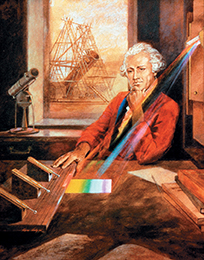18.2 The Electromagnetic Spectrum
Reading Focus
Key Concepts
 What waves are included in the electromagnetic spectrum?
What waves are included in the electromagnetic spectrum? How is each type of electromagnetic
How is each type of electromagnetic
Vocabulary
electromagnetic spectrum
amplitude modulation
frequency modulation
thermograms
Reading Strategy
Summarizing Copy the chart below and add four more rows to complete the table for the electromagnetic spectrum. After you read, list at least two uses for each kind of wave.
Type of Waves |
Uses |
|
|---|---|---|
Radio Waves |
Communications |
a. |
Infrared Rays |
b. |
Keeping food warm |
How do you investigate something that is invisible? First you have to suspect that it exists. Then you have to figure out a way to detect what is invisible and collect data about it. Such was the way the German-born astronomer William Herschel (1738—1822) discovered infrared radiation.
The Waves of the Spectrum
In England in 1800, with a technique discovered earlier, Herschel used a prism to separate the wavelengths present in sunlight. He produced a band of colors: red, orange, yellow, green, blue, and violet. He wondered if the temperature of each color of light was different from the temperature of the other colors of light. As you can see in Figure 8, Herschel placed thermometers at various places along the color band and measured the temperatures. Herschel observed that the temperature was lower at the blue end and higher toward the red end.
Figure 8 Herschel measured the temperature of different colors of light. The temperature was lowest at the blue end and highest at the red end. Curiosity led Herschel to discover evidence of radiation past the red end of the band of visible light.

This discovery made Herschel pose a new question: Would the temperature increase even more beyond the red end, in an area that showed no color? He measured the temperature just beyond the red end of the color band. This area recorded an even higher temperature than the red area. Herschel concluded there must be invisible radiation beyond the red end of the color band.





